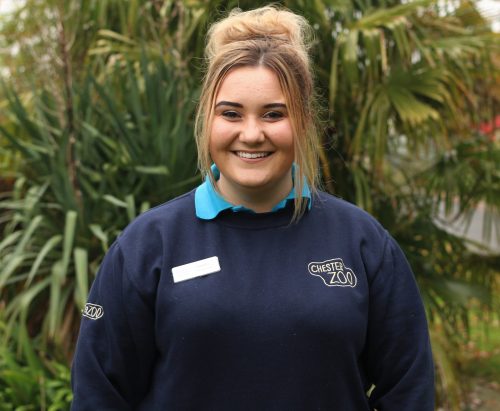We continually evaluate our animal husbandry practices to maintain optimal standards of animal wellbeing. For our male Malayan sun bear, Toni, this includes how we provide food when encouraging natural behaviour.
Sun Bears are found in the rainforests of South East Asia, but deforestation and the conversion of natural forests to palm oil plantations have contributed to their declining population in the wild. Sun bears are also under threat from the illegal wildlife trade. Bears are taken from the wild to be kept as pets, or for the harvesting of their organs and bile for use in traditional Asian medicine, despite zero scientific proof of any medicinal value.
Toni was rescued from the illegal wildlife trade as a cub by a conservation team from Free the Bears working in Cambodia. Toni, and his rescued partner Milli, moved to the Rare Species Conservation Centre in Kent before journeying on to Chester Zoo in 2015. The pair produced a cub, Kyra, in June 2018, a UK first for this species and hugely momentous for the sun bear conservation breeding programme. Currently, Toni lives alongside Milli and Kyra in the Islands area of the zoo. As part of his routine husbandry, Toni receives a variety of enrichment with the aim to encourage natural foraging behaviour and ultimately optimise animal wellbeing.
Tash Whitehouse is studying a BSc in Animal Science at the University of Reading and is our former Nutrition Intern. Alongside our Conservation Scientists, she spent the last academic year formulating and reviewing diets for all species in the zoo collection. Evaluating Toni’s feeding enrichment provided Tash with the perfect opportunity to combine her interests of animal nutrition and behaviour.

Our carnivore keepers were interested in knowing which type of feeding enrichment was the most effective at encouraging natural behaviour.
Tash Whitehouse, Former Nutrition Intern at Chester Zoo
“I evaluated nine different ways that we present food to Toni, splitting them into visual, manipulation, and scent-based devices. Some of the enrichment included hiding food in the habitat, a honey or peanut butter trail, bamboo puzzle feeders, and hanging log feeders. I recorded Toni’s behaviour for one hour before the enrichment was given and compared this to his response to the items.”
It is important that enrichment is frequently changed to ensure that Toni maintains interest in the device and, therefore, continues to display natural behaviour expected by bears in the wild. Such behaviour is important to maintain in zoos as these natural behaviours can be passed down generations through social learning. If a wide repertoire of natural behaviours is not maintained in zoo individuals, there is a risk that any individuals that are reintroduced back to the wild may not survive as they do not possess the necessary skills to forage for food.
Tash added, “All of the visual, manipulation, and scent-based devices presented to Toni were effective at encouraging natural behaviour, with increases seen in foraging and investigative behaviours after the enrichment was given.Toni seemed particularly interested in the hanging log feeders which was great to watch as he used his claws to handle and twist the log so that food would drop out of the drilled holes.”
The results of Tash’s study will be used by our Carnivore team to inform how we provide feeding enrichment to Toni. We will continue to monitor how Toni responds to different feeding enrichment to ensure he does not become accustomed to any one particular device. Future work will also assess the effectiveness of feeding enrichment for partner, Milli, and daughter, Kyra.
Now that Tash has completed her year-long placement, we asked her to reflect on her time at Chester Zoo and tell us her plans for the future:
My time at Chester Zoo has been amazing! I didn’t know a lot about bears before I started this placement but now they’re one of my favourite animals. Despite his tough start in life, Toni is such a character and being able to watch him every day was fantastic.
Assisting in the Nutrition programme across a wide variety of species was also extremely interesting as every day was different. Now that I am finishing this placement year I feel well prepared to go back to university in September. Working across multiple projects and writing reports for keepers and curators should help me when organising my workload for my final year. I am currently collecting data here at Chester Zoo comparing the habitat use and activity of black and greater one-horned rhinos for my dissertation project. I’m going to miss the zoo and working with everyone in the Science Team, but I’m looking forward to going back to university and applying everything I have learned here.”
Illegal wildlife trade is the greatest direct threat to the future of many of the world’s most iconic species.